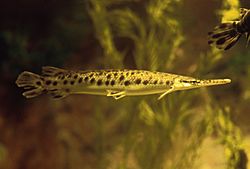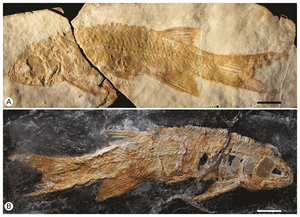Holostei facts for kids
Quick facts for kids HolosteiTemporal range: Jurassic - Recent
|
|
|---|---|
 |
|
| Spotted gar, Lepisosteus oculatus | |
 |
|
| Bowfin, Amia calva | |
| Scientific classification | |
| Kingdom: | |
| Phylum: | |
| Class: | |
| Subclass: | |
| Infraclass: |
Holostei
|
| Orders | |
|
Amiiformes |
|
Holostei (say "HOH-loh-stee") are a group of bony fish. They have some features that are considered "primitive," meaning they are like older types of fish. Today, there are eight different species of Holostei. These species are split into two main groups, called orders. One order is the Amiiformes, which has only one living fish: the bowfin. The other order is the Lepisosteiformes, which includes the gars. Scientists have found many more types of Holostei in the fossil record, showing they were once more common.
Contents
What Makes Holostei Special?
Holostei are a type of ray-finned fish. They have a mix of features from two other big fish groups: teleosts (which are most modern fish) and sharks. Compared to another ancient group of ray-finned fish called chondrosteans, Holostei are more like teleosts and less like sharks.
Body Features
- Spiracles: Sharks and chondrosteans have a pair of small breathing holes called spiracles. In Holostei, these are much smaller. For gars, these spiracles don't even open to the outside.
- Skeleton: Holostei have skeletons that are only lightly ossified, meaning they don't have a lot of hard bone. Bowfins, for example, have a thin layer of bone covering a skeleton that is mostly cartilage (a softer, flexible material like in your nose).
- Tail: Gars still have a heterocercal tail. This means the top part of their tail fin is longer than the bottom part. It's similar to a shark's tail, but less extreme than in chondrosteans.
- Fins: Bowfins have many rays in their dorsal fin (the fin on their back). They can also breathe air, just like some other fish such as the bichirs.
Scales
The gars have very thick, diamond-shaped scales called ganoid scales. These are similar to the scales found on sturgeons. The bowfin, however, has thinner, rounder scales that are more like those of modern teleost fish. Because of their scales, gars are often seen as more "primitive" than bowfins.
The Name "Holostei"
The name Holostei comes from the Greek words holos, meaning "whole," and osteon, meaning "bone." This name refers to their bony skeletons, even if they are only lightly ossified.
Holostei in the Fish Family Tree
Scientists use something called a cladogram to show how different living things are related to each other. Think of it like a family tree for animals! The cladogram below shows where Holostei fit in the bigger family of bony fish. Most bony fish today are teleosts. This tree also shows how land animals, called tetrapods, evolved from a group of fish related to these. The dates show roughly when these groups first appeared.
| Osteichthyes |
|
||||||||||||||||||||||||||||||||||||||||||||||||||||||
See also
 In Spanish: Holósteos para niños
In Spanish: Holósteos para niños


